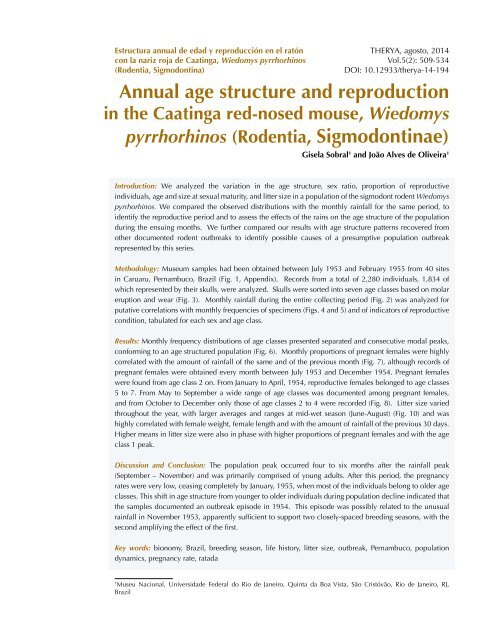therya-5_2
therya-5_2
therya-5_2
Create successful ePaper yourself
Turn your PDF publications into a flip-book with our unique Google optimized e-Paper software.
Estructura annual de edad y reproducción en el ratón<br />
con la nariz roja de Caatinga, Wiedomys pyrrhorhinos<br />
(Rodentia, Sigmodontina)<br />
THERYA, agosto, 2014<br />
Vol.5(2): 509-534<br />
DOI: 10.12933/<strong>therya</strong>-14-194<br />
Annual age structure and reproduction<br />
in the Caatinga red-nosed mouse, Wiedomys<br />
pyrrhorhinos (Rodentia, Sigmodontinae)<br />
Gisela Sobral 1 and João Alves de Oliveira 1<br />
Introduction: We analyzed the variation in the age structure, sex ratio, proportion of reproductive<br />
individuals, age and size at sexual maturity, and litter size in a population of the sigmodont rodent Wiedomys<br />
pyrrhorhinos. We compared the observed distributions with the monthly rainfall for the same period, to<br />
identify the reproductive period and to assess the effects of the rains on the age structure of the population<br />
during the ensuing months. We further compared our results with age structure patterns recovered from<br />
other documented rodent outbreaks to identify possible causes of a presumptive population outbreak<br />
represented by this series.<br />
Methodology: Museum samples had been obtained between July 1953 and February 1955 from 40 sites<br />
in Caruaru, Pernambuco, Brazil (Fig. 1, Appendix). Records from a total of 2,280 individuals, 1,834 of<br />
which represented by their skulls, were analyzed. Skulls were sorted into seven age classes based on molar<br />
eruption and wear (Fig. 3). Monthly rainfall during the entire collecting period (Fig. 2) was analyzed for<br />
putative correlations with monthly frequencies of specimens (Figs. 4 and 5) and of indicators of reproductive<br />
condition, tabulated for each sex and age class.<br />
Results: Monthly frequency distributions of age classes presented separated and consecutive modal peaks,<br />
conforming to an age structured population (Fig. 6). Monthly proportions of pregnant females were highly<br />
correlated with the amount of rainfall of the same and of the previous month (Fig. 7), although records of<br />
pregnant females were obtained every month between July 1953 and December 1954. Pregnant females<br />
were found from age class 2 on. From January to April, 1954, reproductive females belonged to age classes<br />
5 to 7. From May to September a wide range of age classes was documented among pregnant females,<br />
and from October to December only those of age classes 2 to 4 were recorded (Fig. 8). Litter size varied<br />
throughout the year, with larger averages and ranges at mid-wet season (June-August) (Fig. 10) and was<br />
highly correlated with female weight, female length and with the amount of rainfall of the previous 30 days.<br />
Higher means in litter size were also in phase with higher proportions of pregnant females and with the age<br />
class 1 peak.<br />
Discussion and Conclusion: The population peak occurred four to six months after the rainfall peak<br />
(September – November) and was primarily comprised of young adults. After this period, the pregnancy<br />
rates were very low, ceasing completely by January, 1955, when most of the individuals belong to older age<br />
classes. This shift in age structure from younger to older individuals during population decline indicated that<br />
the samples documented an outbreak episode in 1954. This episode was possibly related to the unusual<br />
rainfall in November 1953, apparently sufficient to support two closely-spaced breeding seasons, with the<br />
second amplifying the effect of the first.<br />
Key words: bionomy, Brazil, breeding season, life history, litter size, outbreak, Pernambuco, population<br />
dynamics, pregnancy rate, ratada<br />
1<br />
Museu Nacional, Universidade Federal do Rio de Janeiro, Quinta da Boa Vista, São Cristóvão, Rio de Janeiro, RJ,<br />
Brazil



